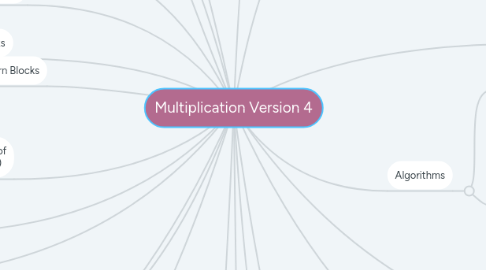Multiplication Version 4
por Kaeta Seimer


1. Multiplication Stacks
2. Pattern Blocks
2.1. To model multiplication patterns
3. Section of the order of operations (PEMDAS)
4. Area Concept
5. Levels of Cognitive Demand
5.1. Low Cognitive Demand
5.2. High Cognitive Demand
6. Cartesian Product
6.1. Determining the number of possible combinations
7. The opposite of division
8. Properties of Multiplication
8.1. Commutative Property
8.1.1. a x b=b x a
8.2. Distributive Property
8.2.1. 5 x (4+3) ---> (5 x 4) + (5 x 3)
8.3. Associative Property
8.3.1. (a x b) x c = a x (b xc )
9. Area Model
10. Near Facts
11. Estimation
12. Fractions
12.1. Greatest Common Factor
12.2. Least Common Factor
12.3. Common Denominator
13. Division
14. Single Digit Multiplication
14.1. Double Digit Multiplication
14.1.1. Multi-Digit Multiplication
14.1.1.1. 120 x 112 = 13,440
14.1.2. 20 x 16 = 260
14.2. 5 x 5= 25
15. Fact Families
15.1. 7 × 5 = 35 5 × 7 = 35 35 ÷ 5 = 7 35 ÷ 7 = 5 35 = 7 × 5
15.1.1. Compensating
16. Number Talks
16.1. Number Sense
16.2. Place Value
16.3. Fluency
16.4. Properties
16.5. Connecting Mathematical Ideas
17. Symbols for the process (x, *, etc.)
18. Algorithms
18.1. Standard Algorithm of multiplication
18.2. Invented Strategies
18.2.1. Doubling and Halving
18.2.2. Partial Products
18.2.3. Breaking Factors into Smaller Factors
18.2.4. Landmark/ "Friendly" Numbers
18.2.5. Skip Counting, Repeated Addition
18.2.5.1. Unifix Cubes
18.2.5.2. Base Ten Blocks
19. Arrays
20. Hidden Zeroes
21. Doubles
21.1. Near Doubles
22. Finger Multiplication
23. Base Ten Blocks
23.1. Using base ten blocks to represent the numbers in a multiplication problem
23.2. Using base ten blocks to construct an array
23.2.1. Using the fewest number of base ten blocks in an array

